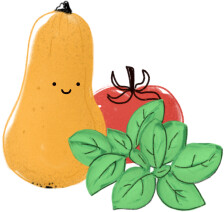Jerusalem artichoke / Topinambur

Jerusalem artichoke / Topinambur
Helianthus tuberosus
Plant family
Daisy family (Asteraceae)
Also known as
Sunroot, Sunchoke, Wild Sunflower, Earth Apple
Season Overview
Sowing
Harvest
J
F
M
A
M
J
J
A
S
O
N
D
Details
Light requirement
Sunny
Water requirement
Moist
Soil
Medium (loamy)
Nutrient requirement
High
Plant distance
60 cm
Row spacing
50 cm
Seeding depth
10 cm
Instructions
The season for this plant is over. The following instructions are for the next season.
Beginning of March
Sowing
End of March
Weeding
Every week
End of July
Harvesting
Description
Botanically, Jerusalem artichoke (Helianthus tuberosus) belongs to the composite family (Asteraceae). The inflorescences resemble those of a sunflower.
Origin:
North and Central America
Growing tips
Normally Jerusalem artichoke is cultivated as an annual. It is unpretentious and does not make great demands on its location, and even nutrient-poor soils can be used. Very well it follows in the crop rotation on crops that leave a loose soil. Waterlogging should be avoided. Jerusalem artichoke appreciates sunny locations, but it is just as comfortable in partial shade. During very early planting, young Jerusalem artichoke plants can be covered with fleece to speed up sprouting. The tubers are placed at a depth of 10 to 12 cm. In principle, the same cultivation technique can be used as for potatoes. That is, the rows are mounded to accelerate the sprouting of the tubers and facilitate their later harvesting. When the leaves fall (collapse), the tubers have reached harvest maturity. To harvest, pull the tubers out of the ground by the stem or carefully dig them up with a garden shovel. Jerusalem artichoke tubers are extremely hardy and can withstand even severe frosts in the ground. Therefore, overwintering with subsequent harvesting in the next spring (before new shoots!) is also possible. To be able to harvest even during frost, the soil should be covered with straw or leaves. Jerusalem artichoke can be grown for several years in the same location.
Companion Plants
No companion plants
Antagonistic Plants
Artichoke
Arugula / Rocket
Aster
Aubergine / Eggplant
Basil
Bean (Dwarf bean)
Bean (Runner bean)
Black salsify
Borage
Broccoli
Brussels sprouts
Cabbage (Cabbage)
Cabbage (Savoy cabbage)
Caraway / Meridian fennel / Persian cumin
Carrots
Cauliflower
Celery (Celeriac / Celery root)
Celery (Celery)
Chamomile
Chard
Chervil
Chives
Collard greens (Kale)
Collard greens (Tuscan kale / Dinosaur kale / Palm tree kale)
Common marigold
Coriander / Cilantro
Corn / Maize
Courgette / Zucchini
Cress
Cucumber / Gherkin
Dill
Fennel
Florence fennel / Finocchio
Garlic
Kohlrabi / German turnip / Turnip cabbage
Leeks
Lettuce (Endive / Escarole / Erisée)
Lettuce (Lamb's lettuce)
Lettuce (Lettuce)
Lettuce (Radicchio / Italian chicory)
Lovage
Marjoram
Melissa
Melon (Watermelon)
Miner's lettuce / Indian lettuce / Winter purslane
Mint
Napa cabbage / Chinese cabbage
Onion
Onion (Spring onion)
Oregano
Pak Choi
Parsley
Parsnip
Pea
Potato
Pumpkin / Squash
Radish
Radishes
Rhubarb
Root parsley
Rosemary
Rutabaga / Swedish turnip
Sage
Savory
Soybean
Spinach (Summer)
Strawberry
Sunflower
Tarragon
Thyme
Turnip
Zinnia
Diseases
Downy mildew
Rust of sunflower
Black spot of roses
Powdery mildews
Pests
Land snails